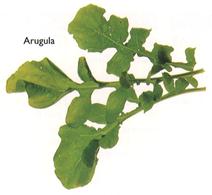|
Additional Arugula Information
Medicinal Uses
Recipes
Magic & Superstition
Herb Index Page
Site Map
Home
Annuals
Architectural Elements
Backyard
Habitat
Biennials
Bonsai
Bulbs
Cactus/Xeriscaping
Companions
Composting
Container
Gardening
Crafts
Gardening Q/A
Garden Ornamentation
Gargoyles
Greenhouses
Ground Covers
Herbs
Houseplants
Insects/Diseases
Landscaping
Organics
Perennials
Ponds
Propagation
Recipes
Roses
Seeds
Shade Gardens
Shrubs/Hedges
Tools
Trees
Vegetables
Vines
Weeds
Wildflowers
Wildlife
Shop Gardening
|
 Also
known as Roquette or Rocket Salad, Arugula is mainly used as a salad
green. It has an assertive, pungent, spicy, peppery, somewhat nutty flavor somewhat
reminiscent of radish or horseradish. It is an annual
herb, grown for its mustard-like leaves. Use it to add zing to salads and stir-fry dishes when
the leaves are tender and young, and to add a tang to potato salads. Mature leaves (which are
tougher) can be cooked along with other greens. Late summer planting will
provide a good fall crop. Leaves can be kept tender by frequent cutting. Also
known as Roquette or Rocket Salad, Arugula is mainly used as a salad
green. It has an assertive, pungent, spicy, peppery, somewhat nutty flavor somewhat
reminiscent of radish or horseradish. It is an annual
herb, grown for its mustard-like leaves. Use it to add zing to salads and stir-fry dishes when
the leaves are tender and young, and to add a tang to potato salads. Mature leaves (which are
tougher) can be cooked along with other greens. Late summer planting will
provide a good fall crop. Leaves can be kept tender by frequent cutting.
Arugula
is one component of mesclun, a mixture of young leaves of various mild herbs,
lettuces, chicories, and endives.
Arugula
is a cool season crop. Its growth requirements are easy, and are similar
to leaf lettuce. It has practically no pests, and matures quickly (2-3
months from seed). It has deeply cut green leaves and white or yellowish flowers with crimson or violet
veins. It makes a good companion plant for other herbs and
vegetables. Please see Companion
Planting for more information. It is native to the Mediterranean region and
grows wild throughout southern Europe.
|
 |
 Also
known as Roquette or Rocket Salad, Arugula is mainly used as a salad
green. It has an assertive, pungent, spicy, peppery, somewhat nutty flavor somewhat
reminiscent of radish or horseradish. It is an
Also
known as Roquette or Rocket Salad, Arugula is mainly used as a salad
green. It has an assertive, pungent, spicy, peppery, somewhat nutty flavor somewhat
reminiscent of radish or horseradish. It is an